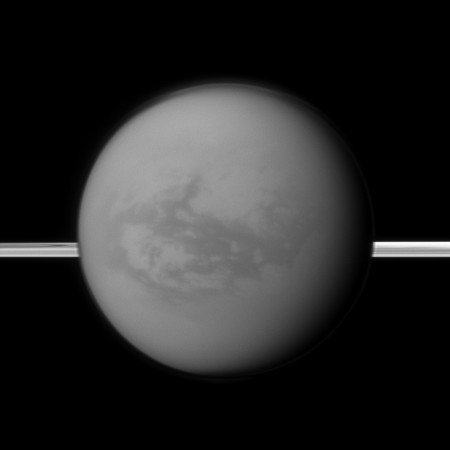Titan Gets A Sexy Infrared Close-Up. Cassini, You Pimp.
Check out this super bombad picture of Titan taken by Cassini back in August. You can see surface detail of the lovely rock, and it’s all thanks to the powers of infrared.
The fact that you can see surface detail on Titan is a dead giveaway this shot was taken in the infrared: optical light, the kind we see, can’t penetrate the thick, hazy, nitrogen/methane atmosphere blanketing this moon. Infrared light gets through, though, so surface features can be seen. In fact, this image was taken using a filter that lets through light at 938 nanometers (the reddest light the human eye can see is about 750 nm). Methane is pretty good at absorbing light at a bunch of different wavelengths, but at 938 nm it’s transparent, so this is a particularly good place in the spectrum to look at Titan – astronomers call it the “methane window”. Not only that, but this image also employed a polarizing filter, which blocks a lot of light from the atmospheric haze, making the surface easier to see (it also makes rainbows appear and disappear, too).
Not that the atmosphere is completely invisible in this picture: look around the moon’s edge and you can just see some of the upper atmospheric layers, and at the top you can easily spot the north polar hood, which may have water ice crystals in it.
And that dark region on Titan’s surface? It may have once been the bed of a methane sea, but now it’s a dry, vast area of wind-blown dunes, hydrocarbon grains collected by the Titanian winds. It’s called Shangri-La, and that makes me smile. I’m not sure anything at -180 °C could be called a human paradise, but for astronomers, it’s certainly a scientific one.
Very cool. (Pun?)




